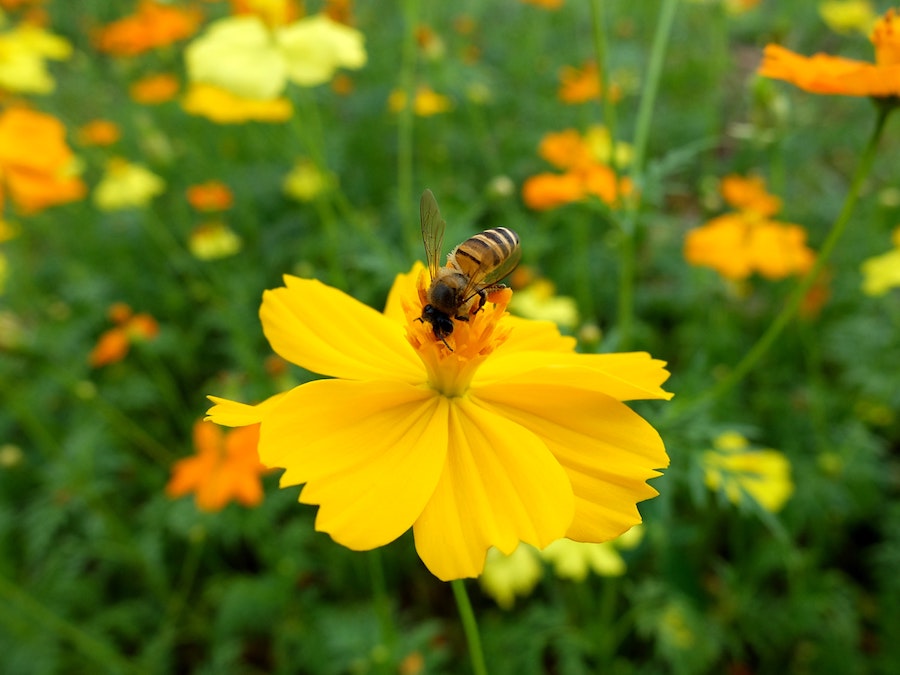Expert tips for turning your outdoor space into a honeybee heaven
It’s ironic that a woman who has spent many years living in close quarters to beehives, and championing a better future for our apian friends, should be allergic to insect stings.
Yet Sarah Wyndham Lewis has run the sustainable beekeeping business, Bermondsey Street Bees (bermondseystreetbees.co.uk) with her husband Dale Gibson for the last decade, and has also transformed a small, neglected patch in Suffolk into a test bed for bee plantings. The story began with just a few window boxes on their roof terrace in London, but as their interest in bee-keeping progressed, they found a profound problem in the wellbeing and ultimate survival of honeybees.
Now, Wyndham Lewis has written a book, Planting For Honeybees, showing people which plants can be of most benefit to bees.
Fancy creating a honeybee buzz in your garden or outdoor space? Here are Wyndham Lewis’ top tips…
How do you tell a honeybee from a bumblebee?

Bumblebees are bigger with more fur
“Bumblebees have a really thick and lovely fur coat, tend to be bigger and have a slightly slumberous gait in the air. They are like teddy bears on wings. Honeybees are smaller. Close-up they are furry, but to the naked eye they look fundamentally quite smooth,” says Wyndham Lewis. “There are a lot of black and yellow bees out there which aren’t honeybees, but which are foraging. If you’re planting for honeybees, you are going to be feeding everything.”
Honeybees have shorter tongues

Honeybees like open flowers
“Honeybees have a very short tongue so you need to plant for them specifically,” she explains. “They can’t access a lot of forage that bumblebees, butterflies and other pollinators, like hoverflies, can. They just can’t get their tongues into the flowers. But if you plant for honeybees, everything else can access it.”
Honeybees are tree-dwellers

Bees love flowering trees
“People often don’t realise that the bee is a tree-dwelling creature, often nesting about 2m high. Most of the forage they get comes from trees and bushes, rather than wildflowers. A single lime (linden) tree in flower is worth 300 square-metres of wildflower meadow. There are so many flowering trees – and that’s where honeybee health lies,” she adds. Even if you only have room for one tree, make it one rich in blossom, such as the linden or apple or rowan.
Honeybees like clumps

Honeybees will only forage on one species of flower at a time, so you need to plant clumps of the same plant. Everything is directed at saving the bee energy – and by transporting pollen from one specific flower to the next, they’ll be cross-fertilising the same species in the process. So if you have a small plot, don’t plant lots of different plants, Wyndham Lewis advises. And if you’ve only got a windowbox, you can stuff it full of the same species, such as snowdrops.
What are their favourites?
Honeybees love sage and oregano, although lavender is better for bumblebees, Wyndham Lewis notes. Spring bulbs, such as crocuses, are also a magnet for honeybees. Small-scale, you could go for scabious, wallflowers and sea-pink, as well as asters in the summer. For honeybees, avoid cottage garden favourites such as foxgloves, which they can’t easily access. She also avoids hybrid roses with complex, blousy petals. Wild dog roses are much more beneficial to honeybees, she says.
They’ll sniff out your flowers
Honeybees can pick up a scent from over a kilometre away, so they should be able to sniff out your plants. If your garden is always in shade, they may choose to forage elsewhere, as plants need warmth for nectar release.
Let your herbs run to seed

Bees love Russian sage
“You have to let the herbs bolt. Don’t pinch out the tops to stop them flowering, or they will be no good for the bees. I plant half for me for the kitchen, and half for the bees.”
Choose open flowers

Petal power
“You want flowers that are open. Every time you add another layer of decorative petals, you are stealing from the food resources. A lot of very showy garden plants are not honeybee-friendly any more.” The flowers she recommends include allium, cranesbill geraniums, asters, coneflowers and rudbeckias, thistles and helenium, while good climbers for honeybees include climbing hydrangea, Clematis armandii and wisteria.
“You have to go back to the older, simpler varieties, which have a big, generous landing place for bees with yellow pollen and a ring of petals. That takes you to daisies a lot of the time.” Some spring bulbs also prove more fruitful to the honeybee than others, including grape hyacinths and crocuses – but not daffodils.
Plus larger, low-maintenance plants

Rosemary is a good bet
Hebes, rosemary and male holly will provide the necessary flowers. “If you have space, put a native fruiting hedge in such as dog rose, blackthorn and blackberry, because you are feeding many species from it including other insects, and making nesting space for the birds. Cherry trees, hawthorn, willow and field maple will all attract honeybees, while the best shrubs include ceanothus, buddleia, viburnum and wild rose. “If you have flowers which honeybees can easily access, then other pollinating insects will follow,” Wyndham Lewis concludes.
The Press Association
Latest posts by The Press Association (see all)
- 5 surprising things you can clean in the washing machine - January 9, 2025
- Prince William posted a heartfelt birthday message to ‘most incredible wife and mother’ - January 9, 2025
- Birthday wishes for Catherine from royal family as the Princess of Wales turns 43 - January 9, 2025
- Maple Cinnamon Granola - January 8, 2025
- 8 things your feet can tell you about your health - January 8, 2025





















